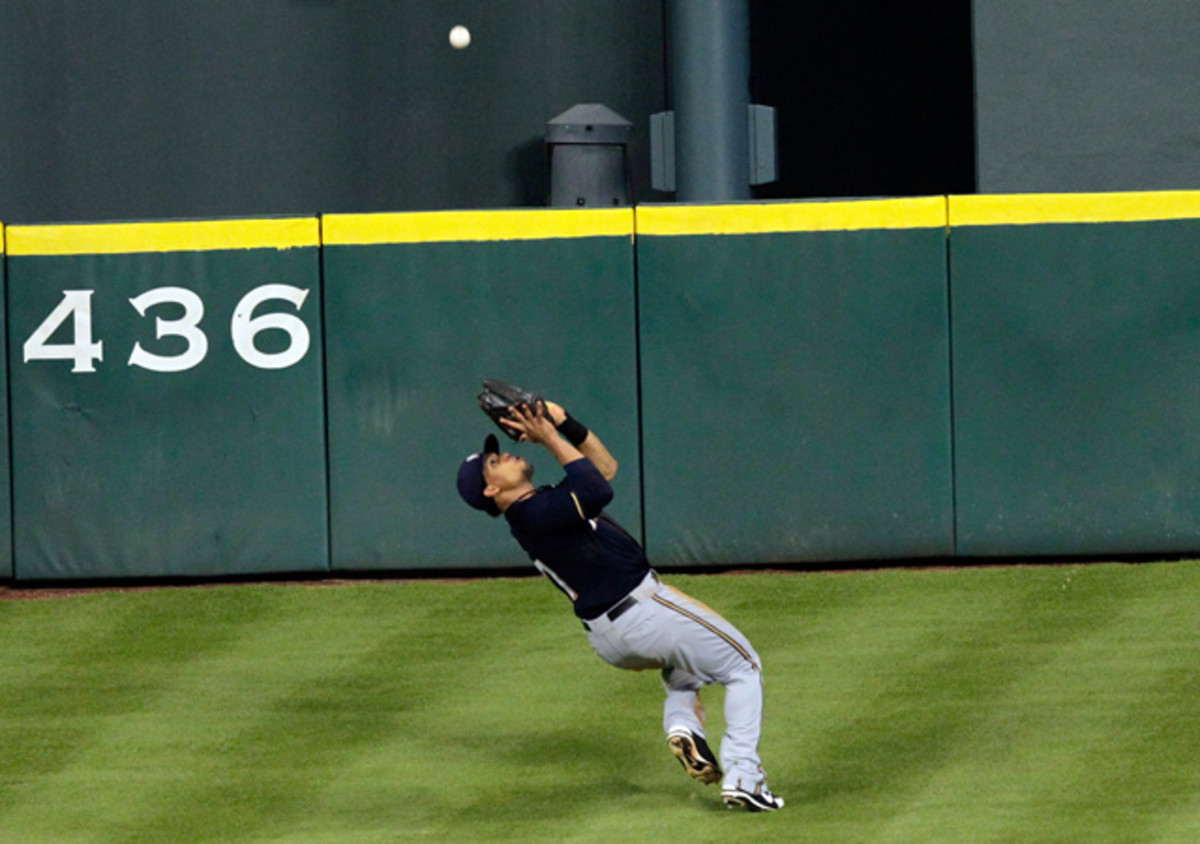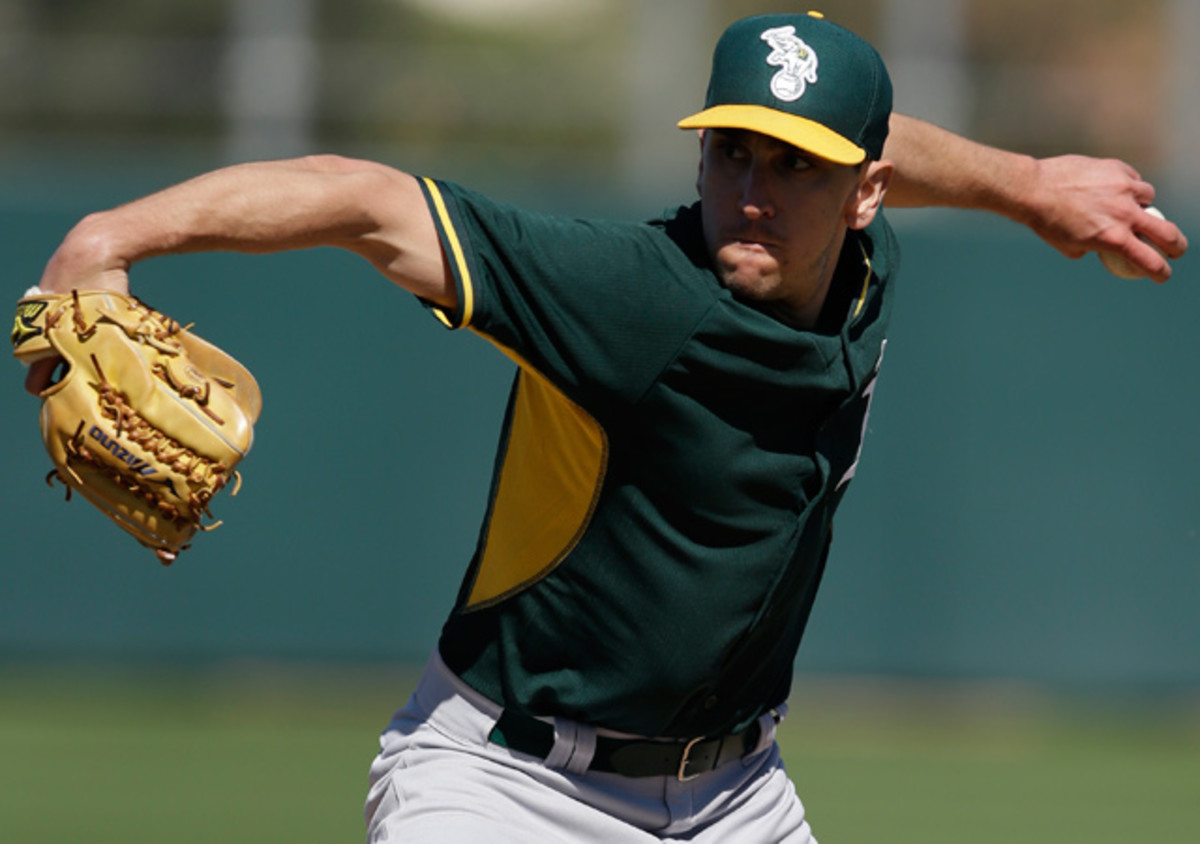Hit and Run: Hello to Anthony Rendon, Pat Venditte; goodbye to Tal's Hill

1. Rendon's return
Though Jayson Werth, Doug Fister and Stephen Strasburg remain on the disabled list, the Nationals are one step closer to being whole now that Anthony Rendon has been activated. The 25-year-old infielder—who had missed 53 games due to a sprained medial collateral ligament in his left knee and then an oblique strain on the left side—made his first appearance for the Nationals on Thursday night, going 2-for-4 with a single and a double in a 2–1 loss to the Cubs.
He should have had one more shot. Rendon was at the plate against closer Hector Rondon in the bottom of the ninth inning, ahead in the count, 2–1, with two outs and Michael Taylor on second base and Clint Robinson on first. Robinson strayed too far from the bag for no good reason, however, and was picked off by catcher David Ross, ending the game. It was a particularly lunk-headed move given that Robinson had no chance to steal second with the base occupied.
The replays show some ambiguity, but Nationals manager Matt Williams had lost a fourth-inning challenge on an attempted steal by Danny Espinosa, so he could not force a review. With the Mets’ win in Arizona, the loss dropped the Nationals (29–25) into second place in the NL East, half a game behind New York.
Blown call shows umpires still struggle on home plate collision rule
Rendon’s return should help them get back to first. The sixth pick of the 2011 draft out of Rice University emerged as an MVP contender last year when he hit .287/.351/.473 with 21 homers, 17 steals, 16 Defensive Runs Saved and 6.6 Wins Above Replacement, good for second in the league. Though he began the season at second base, he wound up playing more at third (126 starts versus 25 at the keystone) due to Ryan Zimmerman’s injuries and throwing woes. The current plan is for Rendon is to play second, with Espinosa (.246/.352/.423 this year) moving into a utility role and Yunel Escobar (.316/.376/.389) remaining at third, but Rendon did move to the hot corner on Thursday after Escobar left the game in the first inning due to a right wrist injury on a checked swing (X-rays were negative, but he’ll be re-evaluated on Friday).
Washington is currently fifth in the league in scoring (4.33 runs per game), but beyond the video-game numbers of Bryce Harper (.328/.467/.706 with 18 homers), Denard Span (.301/.342/.479) is the only player with a slugging percentage above Espinosa’s .423; that trio plus Escobar are the only Nationals with an OPS+ above 100. Zimmerman (.217/.276/.364) has been terrible offensively, as has Ian Desmond (.242/.288/.372). As bad as he’s been with the bat, Desmond has been even worse afield (13 errors, -3 DRS, -5 UZR), and the team as a whole ranks dead last in the league in defensive efficiency (.665, 22 points below the NL average).
Rendon’s return can’t quite make the offense whole, however, due to the absence of Werth, who struggled to a .208/.294/.287 line in 27 games bracketed by a season-opening stint on the DL due to January surgery on his right shoulder and then a May 15 plunking that fractured his left wrist in two places. He’s targeting an Aug. 1 return, though his history of injuries in that wrist—which via various injuries cost him all of 2006 and parts of '05 and '12—suggests that could be optimistic.
• CHEN: Rookie pitcher Lance McCullers is new X-factor for Astros

2. Over, the Hill
Tal's Hill is going away. On Thursday, the Astros received preliminary approval to undertake a $15 million renovation of Minute Maid Park, one that includes the removal of the majors' most distinctive ballpark quirk this side of the Green Monster.
Lance McCullers's 10-strikeout, zero-walk game illustrates bigger trend
Named after longtime Astros executive Tal Smith, Tal's Hill is a 90-foot-wide terrace that climbs at a 30-degree incline to the centerfield wall, 436 feet away from home plate. In helping to design the team's post-Astrodome venue, Smith—who got his start in the Reds' front office—wanted to pay tribute to the inclined leftfield terrace at Cincinnati's Crosley Field (see here and here). Other parks have featured inclines as well, including Fenway's "Duffy's Cliff," a 10-foot incline in front of the Green Monster from 1912 to '33 which acquired its nickname from nimble outfielder Duffy Lewis, who had a knack for dealing with it.
A polarizing feature among fan, players, and managers, Tal’s Hill also includes an in-play flagpole, an homage to old Tiger Stadium and Yankee Stadium. Many criticized the quirk for exposing players to an additional injury risk, yet no injuries have ever been connected to it.
Few home runs have been hit over it. Via the Baseball-Reference.com Play Index, only 34 home runs have been hit to centerfield in the 16-year existence of what was originally known as Enron Field, though a quick review of a sample of videos shows that not all of them actually went over the hill—some were more to left- or right-centerfield. The most recent one, by George Springer off the Braves' Aaron Harang last June 24 and estimated at 465 feet by ESPN Home Run Tracker, was bona fide:
Prior to that, you have to go back to Hunter Pence's May 21, 2009 homer off the Brewers' Jeff Suppan to find one that truly went over the Hill. Via B-Ref, Lance Berkman is the leader with home runs to Enron/Minute Maid's centerfield with 12—more than a third of the total—followed by Jeff Bagwell with five and Richard Hidalgo with three, but there's no confirmation of how many of those are in Hill country. Berkman did make one of the great catches in the Hill's history. Check out this montage, which also includes Andruw Jones (failing to make a catch), Carlos Beltran, Sam Fuld and Jake Marisnick, among others:
The renovations—which had to receive the approval of the Harris County-Houston Sports Authority (which serves as the landlord for the city of Houston and county taxpayers, who own the park)—will bring the centerfield fence in to 409 feet, the sixth-deepest in the majors The real reason for them isn’t safety but money, of course. Via MLB.com's Brian McTaggart, the new centerfield area will include "three new bar locations, four additional food locations and a premium group seating area at field level, creating the first field-level seating area available at Minute Maid Park." Maximize that dollar yield per patron per square foot, because God forbid, fans might not have enough places to drink.
• CORCORAN: Josh Donaldson, Mike Trout neck and neck for AL MVP

3. A’s make the switch to Venditte
At long last, switch-pitcher Pat Venditte is getting the call to the majors. The 29-year-old reliever who throws with both hands is in his eighth minor league season and his first with the Athletics. He’s currently pitching to a 1.36 ERA with 33 strikeouts in 33 innings for Oakland’s Triple A Nashville affiliate, where he’s dominated lefties (.095/.136/.095 in 45 PA) and held his own against righties (.208/.318/.306 in 86 PA).
Prior to signing a minor league deal with an invitation to spring training back in November, Venditte spent seven years in the Yankees’ organization after being drafted out of Creighton University in the 20th round in 2008. The Yankees promoted him as far as Triple A but never invited him to major league camp, let alone called him up. The closest he got was pitching in one Grapefruit League game each year from '10 to '12 as an early-spring roster filler; I wrote about his '10 debut in a split-squad game at Baseball Prospectus.
Kris Bryant or Carlos Correa: Which super prospect would you choose?
In his seven seasons in the Yankees' organization, Venditte put up a 2.46 ERA with 10.1 strikeouts and 2.4 walks per nine. Those numbers look very good on paper (or screen), but scouts have generally been skeptical that his stuff would play at the major league level. Though he could initially throw overhand in the low 90s from the right side, that’s changed since he underwent surgery on his right labrum, an injury that cost him most of the 2012 season. Cliff Corcoran, who took a more in-depth look at Venditte in March, wrote of his current repertoire, “He throws sidearm with a fastball that tops out in the mid-80s, a mid-70s changeup and a slider which can dip into the 60s but is nonetheless his out pitch.” That doesn’t sound like much, but always having the platoon advantage, as well as coming at same-side hitters sidearm, does produce a level of nastiness that at the very least has been effective against minor leaguers. Here's a look at him in spring training:
Via Rule 8.01(f)—which was specially created to accommodate him after a 2008 New York-Penn League fiasco in which he and an opposing switch-hitter spent an eternity taking turns switching sides—Venditte must visually declare which arm he’s going to use prior to the start of a plate appearance and can’t switch during the encounter, which at least gives him the choice of working to a switch-hitter’s weaker side. He uses a special six-fingered glove designed by Mizuno, which originally created the model for Greg A. Harris, the last pitcher to go ambidextrous at the major league level. Pitching for the Expos in 1995, in the penultimate game of his 15-year major league career, the normally righty Harris threw lefty to two hitters.
That was the first time in more than 100 years that a major league pitcher had given hitters the ol’ righty-lefty in a game. Writing at Futility Infielder in 2002, I covered the exploits of Tony Mullane (once in 1882, once in 1893), Larry Corcoran (1884) and Elton “Icebox” Chamberlain (1888) as well that of future major league shortstop Bert Campaneris, who in 1962 did so in a Florida State League game. Campaneris worked exclusively as a righty in his one-inning stint for the Kansas City A’s in a 1965 game where he played all nine positions.
No doubt we’ll have more here at SI.com once Venditte actually gets into a game. Suffice to say that the baseball world—particularly Cliff and me, who both covered the Yankees for years via blogs and the YES Network Pinstriped Bible—has been primed for this occasion for a long time.
